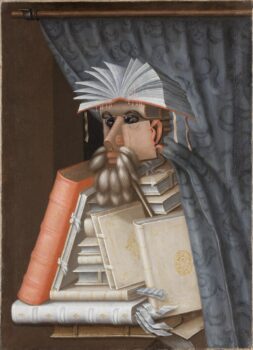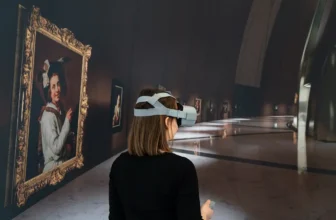Meaning of The Librarian by Giuseppe Arcimboldo
In the history of Renaissance art, few painters stand out quite like Giuseppe Arcimboldo, the Milanese master known for his surreal, composite portraits made entirely of inanimate objects, fruits, vegetables, fish, flowers, and, in the case of The Librarian, books. Painted around 1566, The Librarian is one of Arcimboldo’s most iconic and mysterious works. At first glance, it is a humorous portrait of a scholarly man composed entirely of books and papers. But beneath the whimsy lies a rich tapestry of meaning, one that critiques, celebrates, and questions the very nature of knowledge, identity, and human pursuit.
Let’s delve into this bizarre and brilliant painting to understand its origins, artistic techniques, symbolism, and current location, and unravel what The Librarian truly represents.
Who Was Giuseppe Arcimboldo?
Born in 1526 in Milan, Giuseppe Arcimboldo (sometimes spelled Arcimboli) was a painter of exceptional imagination and technical skill. His early work followed the traditional religious and Gothic style of his father, Biagio Arcimboldo, but it was his court career, particularly his time serving the Habsburg emperors in Vienna and Prague, that allowed his unique vision to flourish.
Arcimboldo became the court painter for Emperor Ferdinand I, and later for Maximilian II and Rudolf II, producing portraits, festival designs, and other visual marvels that catered to the intellectual curiosity and scientific spirit of the time. His composite portraits, a genre entirely of his own invention, earned him international fame and admiration, even centuries later, influencing artists like Salvador Dalí and the Surrealists.
One of the most famous of these imaginative portraits is The Librarian (ca. 1566).
What Type of Art Is The Librarian?
The Librarian is best classified as a work of Mannerist and proto-Surrealist art. Mannerism, the dominant European art style of the late Renaissance, often featured exaggerated proportions, unusual compositions, and intellectual sophistication. Arcimboldo’s fantastical style fits well into this mold, though his work was so unorthodox that it defied easy categorization.
Today, Arcimboldo is frequently considered a precursor to Surrealism, as his imaginative and symbolic approach to portraiture, blending the real with the illogical, echoes the visual trickery and psychological themes of 20th-century surrealist painters. In The Librarian, the illusion of a human made of books creates a jarring, dreamlike effect that is both fascinating and unsettling.
How Was The Librarian Painted?
Arcimboldo’s process combined technical mastery with fantastical composition. Unlike purely abstract painters, he meticulously rendered each object, whether a scroll, book spine, or page, with lifelike detail. This precise rendering allowed the illusion to work effectively; the viewer can instantly recognize individual books while also seeing the cohesive human figure they compose.
He used oil on canvas, the preferred medium of the time, allowing for fine brushwork and deep color saturation. Each book in the portrait is positioned in such a way that it mirrors the structure of a man: tightly stacked tomes form the torso and chest, smaller books create the facial features, and a quill or feather serves as a beard. The painter used chiaroscuro (contrast of light and dark) to give depth and form to the otherwise flat surfaces of the books, and arranged them in layers to create a convincing three-dimensional figure.
Arcimboldo’s genius lay not only in his painting technique but in his ability to make everyday objects function on multiple levels, as components of a still life and as integral parts of a human face or body.
What Is Happening in The Librarian?
In The Librarian, we see a figure composed entirely of books, scrolls, bookmarks, and paper, arranged in such a way that they mimic the anatomical features of a man. A thick stack of books creates the torso, the face is formed from neatly aligned volumes, and a feather quill takes the place of a beard or mustache. The clothing is rendered as folded paper or book bindings, giving the entire figure an air of scholarly decorum.
There is no traditional background or setting, this figure appears against a dark, neutral backdrop, which further emphasizes the strangeness and artifice of the composition. The subject is shown in a three-quarter view, just like many traditional Renaissance portraits. The gaze is neutral, perhaps even smug, as if the book-man is self-satisfied in his accumulation of knowledge.
The painting is both humorous and critical. It seems to celebrate the figure’s scholarly aura while simultaneously poking fun at his possible obsession with books as objects rather than tools of wisdom.
What Does The Librarian Represent?
The Librarian is a commentary on intellectualism, materialism, and the nature of knowledge. It invites multiple interpretations, depending on the viewer’s perspective:
1. Celebration of Scholarship
One interpretation sees The Librarian as a tribute to the learned men of the Renaissance, collectors of knowledge, custodians of culture, and lovers of books. During the 16th century, the role of the librarian was evolving, and libraries themselves were becoming symbols of elite education and human achievement.
The painting may thus honor such intellectual pursuits, depicting the librarian as literally composed of what he loves: books.
2. Satire of Pedantry and Book-Worship
A contrasting interpretation suggests that Arcimboldo was mocking rather than praising. In this view, The Librarian satirizes those who accumulate books for prestige, not understanding. The figure becomes a grotesque parody of the academic who knows everything about books but little about life.
This reading aligns with the Renaissance distrust of pseudo-intellectuals, those who valued appearances and possessions over actual wisdom. The fact that the librarian has no eyes, no ears, no mouth, only books, could symbolize his isolation, lack of engagement, or inability to connect ideas beyond their physical form.
3. Commentary on Materialism
Another symbolic reading focuses on materialism. Books, though associated with knowledge, are also possessions. The painting might critique those who hoard knowledge like wealth, using it for personal status rather than shared enlightenment.
This interpretation is particularly interesting given that Arcimboldo painted for emperors who amassed not only books but wonders, rare objects, and natural oddities in cabinets of curiosities. The Librarian may reflect unease with this culture of accumulation.
Symbolism in The Librarian
The genius of Arcimboldo lies in how he transforms common objects into allegorical elements. Here’s a closer look at some of the symbolic features in the painting:
– Books: Of course, books are the central symbols here. They represent knowledge, education, memory, and power. But when they form the entire body of a person, they also become a critique, knowledge without humanity.
– Scrolls and Papers: These might symbolize older forms of learning, history, or bureaucracy. Their inclusion alongside bound books suggests an archive of tradition.
– Quill (Beard or Mustache): The quill, often a tool for writing, may allude to scholarship or authorship. Placed as facial hair, it adds a satirical touch, turning a sign of wisdom into decoration.
– Lack of Facial Expression: The figure does not have eyes, lips, or a nose. This could symbolize blindness to real-world experiences, or detachment from human emotion and sensory life.
– Uniformity of Color: The beige, brown, and muted tones of the books and background strip the figure of vitality. It becomes an embodiment of dry academia, lifeless in its rigid formality.
What Is the Painting All About?
Ultimately, The Librarian is about the ambivalence of knowledge. In the Renaissance, learning was both a source of liberation and a means of social control. Arcimboldo’s painting reflects this tension.
It doesn’t give us a clear moral, but rather a provocative visual puzzle: Is this man wise or foolish? Noble or vain? Is he made greater by the books, or is he dehumanized by them?
That ambiguity is what makes The Librarian endure. It is not just a clever painting, it is a reflection of our own attitudes toward education, identity, and the limits of knowledge.
Arcimboldo painted The Librarian during a time when Europe was experiencing significant transformations in science, art, religion, and politics. The Renaissance had reignited interest in classical learning, and libraries were becoming powerful cultural institutions.
However, this period also saw the beginnings of the Counter-Reformation and growing skepticism about who controlled knowledge and how it was used. The painting may have been part of a broader cultural critique of academic elitism and institutional knowledge.
Some scholars believe The Librarian was modeled on Wolfgang Lazius, the Austrian humanist and historian who served as imperial librarian under Maximilian II. If so, the painting could be both a portrait and a caricature, combining personal homage with social satire.
Where Is The Librarian Located Today?
Today, The Librarian is housed in the Skokloster Castle in Sweden, one of the best-preserved Baroque castles in Europe. The painting was acquired by Swedish forces during their military campaigns across Central Europe in the 17th century and became part of the castle’s extraordinary art collection.
Though the original remains in Sweden, versions and copies exist in several museums, including a variant in private collections. High-resolution images and reproductions have allowed scholars and viewers around the world to study the painting in detail.
Modern Influence
The Librarian continues to inspire contemporary artists, illustrators, surrealists, and digital creators. Arcimboldo’s unique blend of realism and fantasy opened the door to modern explorations of identity and symbolism.
In an age of information overload and digital hoarding, the painting feels more relevant than ever. We, too, are surrounded by data, storing books in virtual libraries, often more focused on possession than understanding. Are we becoming like Arcimboldo’s librarian, made of knowledge, but unable to see or feel?
Giuseppe Arcimboldo’s The Librarian is more than a whimsical portrait, it is a profound statement on the power and pitfalls of knowledge. Painted with exquisite detail and wit, it captures the essence of the Renaissance spirit while challenging its intellectual excesses.
Through this bookish figure, Arcimboldo invites us to ask hard questions: What defines a person? What is knowledge without wisdom? And in our quest to possess information, are we losing something essential about our humanity?
Over 450 years later, The Librarian still speaks, silently, symbolically, and with endless complexity.




